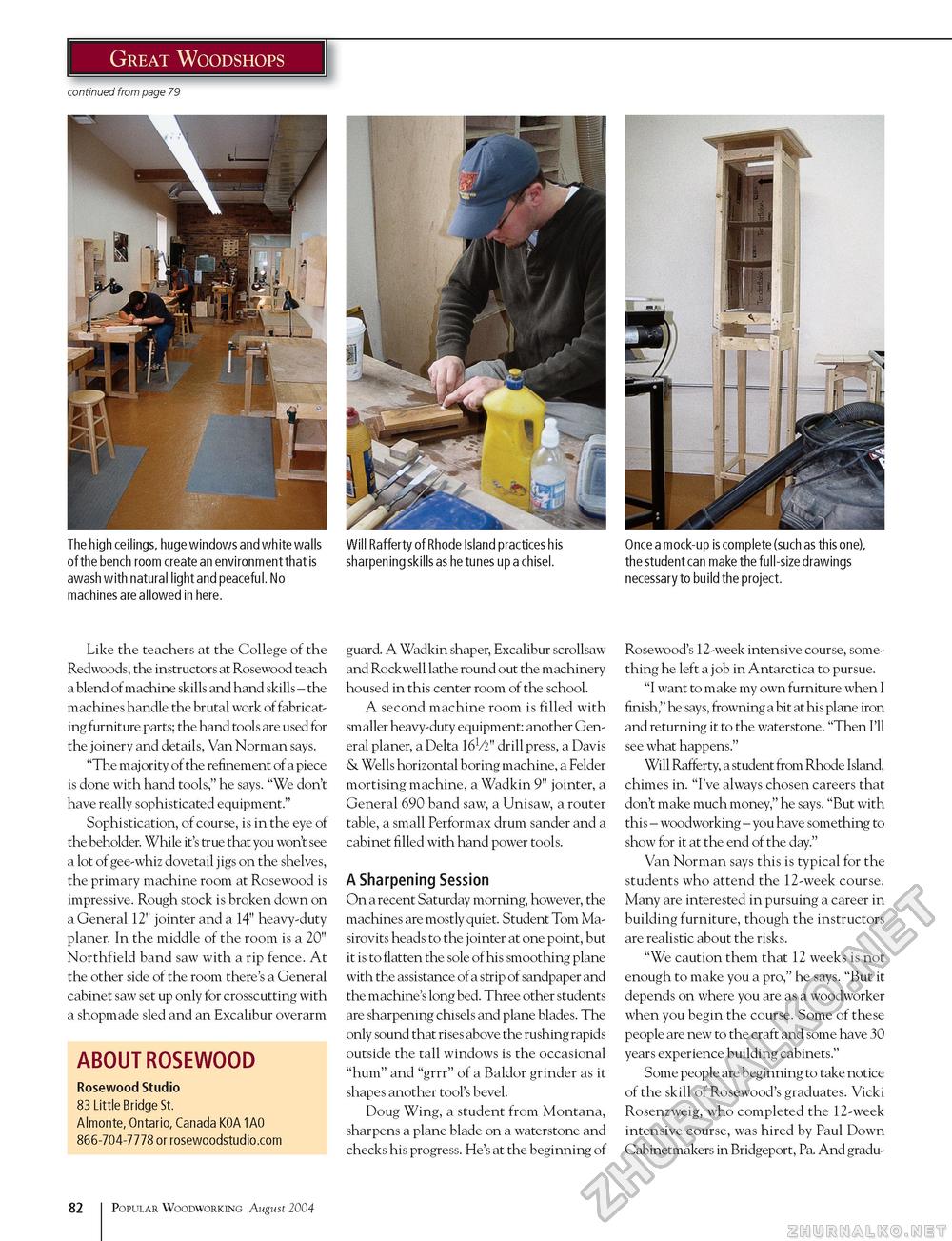Popular Woodworking 2004-08 № 142, страница 84
Great Woodshops continued from page 79 The high ceilings, huge windows and white walls of the bench room create an environment that is awash with natural light and peaceful. No machines are allowed in here. Like the teachers at the College of the Redwoods, the instructors at Rosewood teach a blend of machine skills and hand skills - the machines handle the brutal work of fabricating furniture parts; the hand tools are used for the joinery and details, Van Norman says. "The majority of the refinement of a piece is done with hand tools," he says. "We don't have really sophisticated equipment." Sophistication, of course, is in the eye of the beholder. While it's true that you won't see a lot of gee-whiz dovetail jigs on the shelves, the primary machine room at Rosewood is impressive. Rough stock is broken down on a General 12" jointer and a 14" heavy-duty planer. In the middle of the room is a 20" Northfield band saw with a rip fence. At the other side of the room there's a General cabinet saw set up only for crosscutting with a shopmade sled and an Excalibur overarm ABOUT ROSEWOOD Rosewood Studio 83 Little Bridge St. Almonte, Ontario, Canada K0A 1A0 866-704-7778 or rosewoodstudio.com Will Rafferty of Rhode Island practices his sharpening skills as he tunes up a chisel. guard. A Wadkin shaper, Excalibur scrollsaw and Rockwell lathe round out the machinery housed in this center room of the school. A second machine room is filled with smaller heavy-duty equipment: another General planer, a Delta 16V2" drill press, a Davis & Wells horizontal boring machine, a Felder mortising machine, a Wadkin 9" jointer, a General 690 band saw, a Unisaw, a router table, a small Performax drum sander and a cabinet filled with hand power tools. A Sharpening Session On a recent Saturday morning, however, the machines are mostly quiet. Student Tom Ma-sirovits heads to the jointer at one point, but it is to flatten the sole of his smoothing plane with the assistance of a strip of sandpaper and the machine's long bed. Three other students are sharpening chisels and plane blades. The only sound that rises above the rushing rapids outside the tall windows is the occasional "hum" and "grrr" of a Baldor grinder as it shapes another tool's bevel. Doug Wing, a student from Montana, sharpens a plane blade on a waterstone and checks his progress. He's at the beginning of Once a mock-up is complete (such as this one), the student can make the full-size drawings necessary to build the project. Rosewood's 12-week intensive course, something he left a j ob in Antarctica to pursue. "I want to make my own furniture when I finish," he says, frowning a bit at his plane iron and returning it to the waterstone. "Then I'll see what happens." Will Rafferty, a student from Rhode Island, chimes in. "I've always chosen careers that don't make much money," he says. "But with this — woodworking — you have something to show for it at the end of the day." Van Norman says this is typical for the students who attend the 12-week course. Many are interested in pursuing a career in building furniture, though the instructors are realistic about the risks. "We caution them that 12 weeks is not enough to make you a pro," he says. "But it depends on where you are as a woodworker when you begin the course. Some of these people are new to the craft and some have 30 years experience building cabinets." Some people are beginning to take notice of the skill of Rosewood's graduates. Vicki Rosenzweig, who completed the 12-week intensive course, was hired by Paul Down Cabinetmakers in Bridgeport, Pa. And gradu 82 Popular Woodworking August 2004 |








